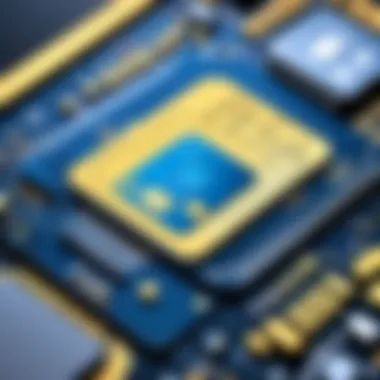Unveiling the Vital Role of SIM Cards in the Modern Tech Landscape


Tech Trend Analysis
In analyzing the current tech trends related to SIM cards, it is essential to understand the foundations that underpin their significance. SIM cards have long been a cornerstone of mobile communication, enabling seamless connectivity and personalized services for consumers. The implications of current trends surrounding SIM cards revolve around the increasing demand for Io T devices and eSIM technology. These advancements not only streamline device connectivity but also pave the way for a more integrated and efficient digital ecosystem. Looking ahead, future predictions suggest a continued shift towards eSIM adoption and innovations in virtual SIM solutions, presenting intriguing possibilities for enhanced connectivity and data management.
Product Reviews
When delving into the world of SIM cards, a comprehensive product review is warranted to navigate the myriad offerings available to consumers. SIM cards vary in terms of form factor, storage capacity, and compatibility with different network standards. Key features to consider encompass data transfer speeds, network coverage, and security protocols. Performance analysis of SIM cards entails evaluating signal strength, data transmission rates, and overall reliability. Pros of modern SIM cards can include increased storage capacity, enhanced security features, and compatibility with a range of devices. However, potential cons may involve limited support for certain technologies and the need for physical access to insert or replace SIM cards. Recommendations for consumers hinge on their specific needs and preferences, with considerations for factors like network coverage, data plans, and device compatibility guiding their choice.
How-To Guides
Introducing beginners to the fundamentals of SIM cards requires a step-by-step breakdown of key concepts and practical considerations. Starting with the basics of what a SIM card is and how it functions, readers can gain a foundational understanding of its role in facilitating mobile communication. Step-by-step instructions for inserting, activating, and managing a SIM card on different devices can aid users in optimizing their mobile experiences. Additionally, offering tips and tricks for improving signal reception, data management, and troubleshooting common issues can empower consumers to make the most of their SIM card capabilities. When facing challenges such as network connectivity issues or SIM card detection problems, troubleshooting tips can guide users through resolving these issues efficaciously.
Industry Updates
Staying abreast of the latest industry developments surrounding SIM cards is vital for tech enthusiasts and professionals alike. Recent advancements in the tech industry have accelerated the adoption of e SIM technology, reshaping traditional approaches to mobile connectivity. Market trends indicate a growing preference for eSIM-enabled devices, signaling a significant transformation in how consumers interact with mobile networks. The impact of these developments on businesses encompasses opportunities for service providers to streamline SIM card provisioning processes, reduce logistics costs, and offer more flexible data plans. For consumers, eSIM adoption translates into increased convenience, global connectivity options, and enhanced data security measures. By analyzing these industry updates, individuals can make informed decisions about adopting eSIM technology and leveraging its benefits in the digital landscape.
Introduction to SIM Cards
In the fast-paced world of technology, where connectivity is key, the humble SIM card plays a pivotal role. Understanding the essence of SIM cards is essential for navigating the complexities of the modern digital landscape. This section will delve into the basic yet crucial components of SIM cards, shedding light on their significance in ensuring seamless communication and data access for a wide array of devices.
What is a SIM Card?
Physical Characteristics
When dissecting the intricate world of SIM cards, one cannot overlook the importance of their physical characteristics. The size, shape, and durability of a SIM card significantly impact its compatibility with various devices. The standard chip size, ranging from mini to nano-SIMs, ensures versatility and widespread usage across multiple gadgets. This adaptability is a boon for consumers looking to switch between devices without constraints. However, the delicate nature of these chips can also pose challenges in terms of damage and data security, highlighting the need for protective measures.


Functionality
Functionality lies at the core of SIM cards, dictating their ability to store crucial data and enable device connectivity. The intricate mechanisms within a SIM card allow it to authenticate users, manage phone numbers, and store contact information. This seamless integration with devices ensures smooth transitions between networks and enhances user experience. Nonetheless, the reliance on SIM cards for critical functions exposes vulnerabilities that must be addressed through robust security measures to safeguard user privacy and data integrity.
Types of SIM Cards
The categorization of SIM cards into various types such as standard SIM, micro-SIM, and nano-SIM caters to diverse consumer needs and technological advancements. Each type offers distinct features and benefits, addressing specific requirements in the ever-evolving tech landscape. While standard SIMs are prevalent in older devices, the compact nature of micro and nano-SIMs has become the norm in modern smartphones and Io T gadgets. This evolution underscores the importance of compatibility and efficiency in meeting consumer demands for sleeker, more powerful devices.
Evolution of SIM Cards
Historical Background
Tracing the evolution of SIM cards unveils a rich history embedded in the progression of communication technology. From the inception of SIM cards in the early '90s to their current ubiquity, these tiny chips have witnessed significant transformations. The shift from full-sized SIM cards to the modern nano-SIMs mirrors the industry's drive towards miniaturization and enhanced functionality. Understanding the historical context of SIM cards provides valuable insights into the evolution of mobile communication and the impact of technological advancements on user convenience.
Advancements in Technology
The realm of SIM cards has not remained static, with continuous advancements propelling them towards greater efficiency and security. Innovations such as Remote SIM Provisioning and embedded SIMs have revolutionized the way devices connect to networks, paving the way for enhanced user experiences. These technological strides underscore the dynamic nature of SIM cards, adapting to meet the demands of a digitally interconnected world. Embracing these advancements is crucial for staying attuned to the latest trends shaping the future of communication technology.
Technical Aspects of SIM Cards
SIM cards play a vital role in today's tech landscape due to their essential functions and components. Understanding the technical aspects of SIM cards is crucial for comprehending their significance. SIM card architecture encompasses various components, security features, and data storage capabilities. Components such as the processor, memory, and contacts are key elements that enable SIM cards to store and transfer information securely. The security features of SIM cards, including encryption and authentication protocols, ensure data protection and prevent unauthorized access. Additionally, the data storage capacity of SIM cards allows for the storage of contacts, messages, and network-related information. Exploring these technical aspects provides insights into the robustness and versatility of SIM card technology.
SIM Card Architecture
Components
The components of a SIM card comprise essential elements that determine its functionality and effectiveness. The processor within a SIM card acts as the brain, handling operations and data processing. Memory modules store data securely, ensuring information remains intact even when the card is removed. Contacts establish connections with devices, enabling seamless communication and data transfer. These components collectively contribute to the reliable performance of SIM cards, making them indispensable in modern technology.


Security Features
Security features embedded in SIM cards are paramount for safeguarding sensitive information and preserving user privacy. Encryption algorithms protect data by encoding it, making it unintelligible to unauthorized users. Authentication mechanisms verify the identity of users and devices, preventing unauthorized access to networks and services. These security features enhance the trustworthiness of SIM cards, ensuring secure communication and data interchange in the digital realm.
Data Storage
Data storage capabilities of SIM cards are essential for storing crucial information such as contacts, messages, and network configurations. The storage capacity varies among SIM cards, ranging from kilobytes to gigabytes, depending on the type and technology. This data storage ensures that users can access their information independently of devices and networks, enhancing convenience and flexibility in mobile communications. Overall, the data storage feature significantly contributes to the functionality and utility of SIM cards in the modern tech landscape.
Applications of SIM Cards
In this section, we delve into the crucial role of SIM cards in various applications within the technological landscape. SIM cards serve as integral components in enabling mobile communication and connectivity across devices. Their importance lies in facilitating voice calls, text messaging, and internet access. Without SIM cards, the seamless operation of these features would be unattainable.
Mobile Communication
Voice Calls
Voice calls via SIM cards are essential for real-time communication, allowing individuals to connect seamlessly regardless of geographic locations. The key characteristic of voice calls is their ability to transmit audio signals effectively over cellular networks. This feature is crucial for individuals requiring immediate and clear communication, making voice calls a popular choice for personal and professional interactions. Despite its benefits, challenges such as call drops and network congestion may impact the user experience.
Text Messaging
Text messaging using SIM cards is a ubiquitous method of communication, offering a convenient way to exchange information in a written format. The key characteristic of text messaging is its asynchronous nature, allowing users to send and receive messages at their convenience. Text messaging is favored for its speed and accessibility, making it a preferred communication tool for quick interactions. However, limitations such as character restrictions and potential delays can affect the efficiency of text communication.
Internet Connectivity
SIM cards play a vital role in providing internet connectivity to mobile devices, enabling users to access online services and information. The key characteristic of internet connectivity through SIM cards is the ability to connect to cellular or Wi-Fi networks, ensuring seamless access to the web. With the increasing reliance on digital platforms, internet connectivity is crucial for individuals relying on mobile devices for work, entertainment, and information retrieval. However, factors like data speed limitations and coverage issues can impact the overall internet experience.


IoT and Connected Devices
Smart Home Technology
In the realm of Io T, SIM cards enable smart home technologies to communicate and operate remotely. Smart home technology utilizes SIM cards to connect devices such as security cameras, thermostats, and lighting systems to the internet. The key characteristic of smart home technology is its ability to automate and control various household functions via connected devices. This technology offers convenience and efficiency, allowing users to manage their homes remotely. However, security concerns and complexities in device integration may pose challenges in adopting smart home solutions.
Wearable Devices
SIM cards play a vital role in wearable devices such as smartwatches and fitness trackers, allowing these devices to stay connected to cellular networks without the need for a smartphone. The key characteristic of wearable devices with SIM card support is their independence from primary devices, providing users with standalone connectivity. Wearable devices offer benefits such as health monitoring, notifications, and communication on the go. However, limitations in battery life and compatibility issues with network providers can influence the user experience.
Emerging Trends in SIM Card Technology
In the fast-paced realm of technology, it is crucial to stay abreast of the latest advancements, particularly concerning SIM card technology. Emerging trends in SIM cards play a pivotal role in shaping the landscape of modern communication devices. From the integration of sophisticated technologies to the seamless connectivity they offer, these trends are revolutionizing the way we interact with our devices.
eSIM Technology
Benefits and Challenges
Delving into the realm of e SIM technology unveils a myriad of benefits and challenges that warrant attention. The primary advantage lies in the compact nature of eSIMs, eliminating the need for physical cards and allowing for easier device integration. Nonetheless, challenges such as compatibility issues with older devices and limited carrier support pose obstacles to widespread adoption. Understanding these nuances is integral to grasping the full potential of eSIM technology in the context of modern connectivity.
Adoption in Devices
The adoption of e SIM technology in devices marks a significant evolution in the realm of SIM cards. By enabling users to switch between carriers seamlessly and reducing the dependence on physical cards, eSIMs offer unparalleled convenience. However, the restricted availability of eSIM-compatible devices and varying implementation across manufacturers present notable challenges. Navigating these complexities illuminates the nuanced impact of eSIM adoption on device functionality and user experience.
5G Integration
Impact on SIM Cards
The integration of 5G technology heralds a new era for SIM cards, unlocking enhanced connectivity and network speeds. One key characteristic is the optimization of SIM card performance to accommodate the increased data demands of 5G networks. This transition underscores the imperative for SIM cards to evolve in tandem with network technologies to ensure seamless functionality. Exploring the implications of this integration provides valuable insights into the future of SIM card technology.
Enhanced Connectivity
Enhanced connectivity is at the core of 5G integration, redefining the parameters of communication and data transfer. The key characteristic of this enhanced connectivity is the ability to transmit data at unprecedented speeds, facilitating real-time interactions and immersive user experiences. While the benefits are evident, challenges such as network coverage and device compatibility remain focal points for further refinement. Delving into the intricacies of enhanced connectivity sheds light on the transformative potential of 5G integration for SIM cards and beyond.



